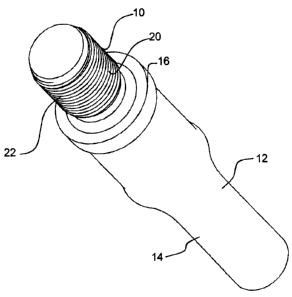Some of the information on this Web page has been provided by external sources. The Government of Canada is not responsible for the accuracy, reliability or currency of the information supplied by external sources. Users wishing to rely upon this information should consult directly with the source of the information. Content provided by external sources is not subject to official languages, privacy and accessibility requirements.
Any discrepancies in the text and image of the Claims and Abstract are due to differing posting times. Text of the Claims and Abstract are posted:
| (12) Patent: | (11) CA 2634557 |
|---|---|
| (54) English Title: | SUCKER ROD |
| (54) French Title: | TIGE DE POMPAGE |
| Status: | Granted |
| (51) International Patent Classification (IPC): |
|
|---|---|
| (72) Inventors : |
|
| (73) Owners : |
|
| (71) Applicants : |
|
| (74) Agent: | WOODRUFF, NATHAN V. |
| (74) Associate agent: | |
| (45) Issued: | 2013-06-11 |
| (22) Filed Date: | 2008-05-07 |
| (41) Open to Public Inspection: | 2009-11-07 |
| Examination requested: | 2011-02-15 |
| Availability of licence: | N/A |
| (25) Language of filing: | English |
| Patent Cooperation Treaty (PCT): | No |
|---|
| (30) Application Priority Data: | None |
|---|
An improvement in a sucker rod having an elongated metal body with opposed ends and threaded couplings positioned at each of the opposed ends comprises a thread form on the threaded couplings defining at least two concurrent helixes. Each of the at least two helixes has a different starting position on a circumference of the threaded coupling.
Une amélioration d'une tige de pompage ayant un corps métallique allongé avec des extrémités opposées et des manchons filetés disposés au niveau de chacune des extrémités opposées comprend une forme de fil sur les manchons filetés définissant au moins deux hélices parallèles. Chacune des au moins deux hélices a une position de départ différente sur une circonférence du manchon fileté.
Note: Claims are shown in the official language in which they were submitted.
Note: Descriptions are shown in the official language in which they were submitted.

For a clearer understanding of the status of the application/patent presented on this page, the site Disclaimer , as well as the definitions for Patent , Administrative Status , Maintenance Fee and Payment History should be consulted.
| Title | Date |
|---|---|
| Forecasted Issue Date | 2013-06-11 |
| (22) Filed | 2008-05-07 |
| (41) Open to Public Inspection | 2009-11-07 |
| Examination Requested | 2011-02-15 |
| (45) Issued | 2013-06-11 |
There is no abandonment history.
Last Payment of $624.00 was received on 2024-03-12
Upcoming maintenance fee amounts
| Description | Date | Amount |
|---|---|---|
| Next Payment if standard fee | 2025-05-07 | $624.00 |
| Next Payment if small entity fee | 2025-05-07 | $253.00 |
Note : If the full payment has not been received on or before the date indicated, a further fee may be required which may be one of the following
Patent fees are adjusted on the 1st of January every year. The amounts above are the current amounts if received by December 31 of the current year.
Please refer to the CIPO
Patent Fees
web page to see all current fee amounts.
| Fee Type | Anniversary Year | Due Date | Amount Paid | Paid Date |
|---|---|---|---|---|
| Application Fee | $400.00 | 2008-05-07 | ||
| Registration of a document - section 124 | $100.00 | 2008-10-15 | ||
| Maintenance Fee - Application - New Act | 2 | 2010-05-07 | $100.00 | 2010-03-16 |
| Request for Examination | $800.00 | 2011-02-15 | ||
| Maintenance Fee - Application - New Act | 3 | 2011-05-09 | $100.00 | 2011-02-15 |
| Maintenance Fee - Application - New Act | 4 | 2012-05-07 | $100.00 | 2012-04-11 |
| Maintenance Fee - Application - New Act | 5 | 2013-05-07 | $200.00 | 2013-03-01 |
| Final Fee | $300.00 | 2013-04-03 | ||
| Maintenance Fee - Patent - New Act | 6 | 2014-05-07 | $200.00 | 2014-02-10 |
| Maintenance Fee - Patent - New Act | 7 | 2015-05-07 | $200.00 | 2015-02-19 |
| Maintenance Fee - Patent - New Act | 8 | 2016-05-09 | $200.00 | 2016-02-17 |
| Maintenance Fee - Patent - New Act | 9 | 2017-05-08 | $200.00 | 2017-02-13 |
| Maintenance Fee - Patent - New Act | 10 | 2018-05-07 | $250.00 | 2018-05-01 |
| Maintenance Fee - Patent - New Act | 11 | 2019-05-07 | $250.00 | 2019-03-26 |
| Maintenance Fee - Patent - New Act | 12 | 2020-05-07 | $250.00 | 2020-04-01 |
| Maintenance Fee - Patent - New Act | 13 | 2021-05-07 | $255.00 | 2021-04-27 |
| Maintenance Fee - Patent - New Act | 14 | 2022-05-09 | $254.49 | 2022-05-04 |
| Maintenance Fee - Patent - New Act | 15 | 2023-05-08 | $473.65 | 2023-02-27 |
| Maintenance Fee - Patent - New Act | 16 | 2024-05-07 | $624.00 | 2024-03-12 |
Note: Records showing the ownership history in alphabetical order.
| Current Owners on Record |
|---|
| DOVER CORPORATION (CANADA) LIMITED |
| Past Owners on Record |
|---|
| PLISKA, ROSS |